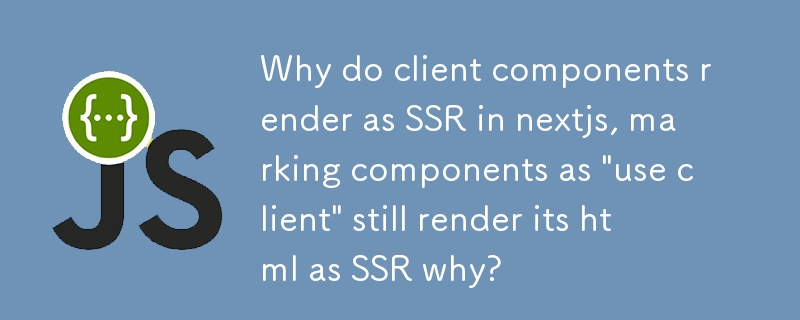Home >Web Front-end >JS Tutorial >Why do client components render as SSR in nextjs, marking components as \'use client\' still render its html as SSR why?
Why do client components render as SSR in nextjs, marking components as \'use client\' still render its html as SSR why?
- Mary-Kate OlsenOriginal
- 2024-10-07 14:22:011232browse

In Next.js, the way client-side components ("use client") work with SSR (Server-Side Rendering) can sometimes be confusing. Let's break it down:
How Client and Server Components Work in Next.js:
- Server Components: These are the default in Next.js and they are pre-rendered on the server. They are not sent to the client as JavaScript but only as HTML.
- Client Components: When you mark a component with "use client", it means the component needs to run on the client-side because it might have interactivity (like useState, useEffect), or relies on browser APIs that don't work in a server environment.
Why Client Components Still Render HTML on the Server:
Even though a component is marked as "use client", the initial HTML for that component can still be generated on the server (SSR), but only for static HTML purposes. This means:
- Initial Render: The server generates the HTML for the page, including the client components, for better performance and SEO. This is static HTML, not interactive.
- Hydration: When this HTML reaches the browser, Next.js hydrates the client-side component with JavaScript, enabling its interactivity.
Why This Happens:
- Performance: By server-rendering the initial HTML, the user can see content faster (faster Time to First Byte, or TTFB) without waiting for the client-side JavaScript to load.
- SEO: Pre-rendering the HTML is important for SEO because it ensures search engines can crawl and index the content.
- Hydration: Once the HTML is served, Next.js sends the JavaScript bundle to the client, which "hydrates" the static HTML, attaching event listeners and making it interactive.
What Happens with "use client"?
- Server-side HTML Rendering: Even though a component is client-side, Next.js still generates HTML for the initial view. So, while it doesn't run interactive JavaScript on the server, it does send HTML markup to the client.
- Client-side Hydration: The JavaScript needed for interactivity is sent to the client, and once the page loads, Next.js hydrates the component, making it fully functional.
Misconception:
Marking a component with "use client" doesn't mean it won't generate any HTML server-side. It simply means that the interactive JavaScript will only be loaded on the client, but the server may still generate the initial static HTML for rendering.
To Summarize:
- SSR of Client Components: The HTML for client components may be pre-rendered on the server (for initial load), but they are not interactive until hydrated on the client.
- "use client": This directive ensures the JavaScript for client-side interactivity is executed only in the browser, but doesn't stop static HTML generation on the server.
If you want to ensure the component behaves differently, you might need to rethink where and how you load certain dynamic content, especially if you're expecting client-specific behavior (like accessing window or document).
The above is the detailed content of Why do client components render as SSR in nextjs, marking components as \'use client\' still render its html as SSR why?. For more information, please follow other related articles on the PHP Chinese website!
Related articles
See more- An in-depth analysis of the Bootstrap list group component
- Detailed explanation of JavaScript function currying
- Complete example of JS password generation and strength detection (with demo source code download)
- Angularjs integrates WeChat UI (weui)
- How to quickly switch between Traditional Chinese and Simplified Chinese with JavaScript and the trick for websites to support switching between Simplified and Traditional Chinese_javascript skills

